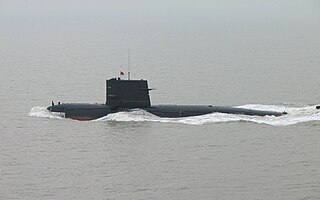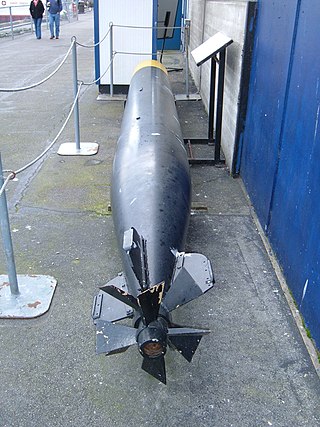Related Research Articles

A modern torpedo is an underwater ranged weapon launched above or below the water surface, self-propelled towards a target, and with an explosive warhead designed to detonate either on contact with or in proximity to the target. Historically, such a device was called an automotive, automobile, locomotive, or fish torpedo; colloquially a fish. The term torpedo originally applied to a variety of devices, most of which would today be called mines. From about 1900, torpedo has been used strictly to designate a self-propelled underwater explosive device.

The Gato class of submarines were built for the United States Navy and launched in 1941–1943. Named after the lead ship of the class, USS Gato, they were the first mass-production U.S. submarine class of World War II.
The Mark 24 Tigerfish was a heavyweight acoustic homing torpedo used by the Royal Navy (RN) during the 1980s and 90s. Conceptual development dates to the mid-1950s, and formally started in 1959 with a target introduction date in 1969. A lengthy development process led to a greatly reduced performance requirement, including the removal of anti-surface capabilities. The first prototype "Tiger Fish" examples were delivered in 1967.

The V-boats were a group of nine United States Navy submarines built between World War I and World War II from 1921 to 1934 under authorization as the "fleet boat" program.

Type 53 is the common name for a family of 53 cm torpedoes manufactured in Russia, starting with the 53-27 torpedo and continuing to the modern UGST (Fizik-1), which is being replaced by the Futlyar.

The SEAL Delivery Vehicle (SDV) is a crewed submersible and a type of swimmer delivery vehicle used to deliver United States Navy SEALs and their equipment for special operations missions. It is operated by SEAL Delivery Vehicle Teams.

The Mark 44 torpedo is a now-obsolete air-launched and ship-launched lightweight torpedo manufactured in the United States, and under licence in Canada, France, Italy, Japan and the United Kingdom, with 10,500 being produced for U.S. service. It was superseded by the Mark 46 torpedo, beginning in the late 1960s. The Royal Australian Navy, however, continued to use it alongside its successor for a number of years, because the Mark 44 was thought to have superior performance in certain shallow-water conditions.

The AUM-N-2 Petrel, also known as Kingfisher C and AUM-2, was an air-to-surface missile produced as part of Project Kingfisher for the United States Navy. Intended for use against enemy surface ships and surfaced submarines, giving aircraft the ability to deliver aerial torpedoes from outside the range of defensive armament, it saw brief operational service in the late 1950s. The project was never considered a high priority by the Navy however, as it was useless against submerged submarines, which were considered the greatest potential threat.

The Mark 24 mine is an air-dropped anti-submarine (ASW) acoustic torpedo developed by the United States during World War II; it was called a mine to conceal its capabilities. The torpedo entered service with the Allies in March 1943; the United States Navy (USN) used it until 1948. Approximately 4,000 were produced. Of the 340 deployed during the war, 204 were fired, sinking 37 and damaging 18 Axis submarines.

The Mark 37 torpedo is a torpedo with electrical propulsion, developed for the US Navy after World War II. It entered service with the US Navy in the early 1950s, with over 3,300 produced. It was phased out of service with the US Navy during the 1970s, and the stockpiles were sold to foreign navies.

The Type 039 submarine is a class of diesel-electric submarines of the People's Liberation Army Navy. The class is the first diesel-electric submarine to be made in China and also the first Chinese made diesel-electric submarine to use the teardrop hull shape. Altogether thirteen vessels were completed to the Song Class design between 1999 and 2006, with three variants as the type developed.

The Mark 14 torpedo was the United States Navy's standard submarine-launched anti-ship torpedo of World War II. This weapon was plagued with many problems which crippled its performance early in the war. It was supplemented by the Mark 18 electric torpedo in the last two years of the war. From December 1941 to November 1943 the Mark 14 and the destroyer-launched Mark 15 torpedo had numerous technical problems that took almost two years to fix. After the fixes, the Mark 14 played a major role in the devastating blow U.S. Navy submarines dealt to the Japanese naval and merchant marine forces during the Pacific War.

The Mark 18 torpedo was an electric torpedo used by the United States Navy during World War II. The Mark 18 was the first electric storage battery torpedo manufactured for the US Navy and it was designed primarily for use as a submarine-launched torpedo.
Yu-5 (鱼-5) torpedo is the first wire-guided torpedo developed by China. It is an ASW torpedo designed for conventional diesel-electric submarines. It is often erroneously referred as the Chinese copy of Soviet TEST-71 torpedo, which is incorrect as the Soviet torpedo was developed in 1971 and its successor TEST-71MKE was developed in 1977, at the worst time of Sino-Soviet split. With Yu-5 entering Chinese service in 1989, it was simply impossible to acquire any technologies of Soviet TEST-71 torpedo, which was not purchased by China until 1993, four years after the Yu-5 torpedo had already entered service. The Yu-5 is not a product of indigenous development and is based largely upon previous Soviet and American designs, with much of the propulsion system being derived from the American Mark 46 lightweight torpedo.
There have been a number of 21-inch (53.3cm) torpedoes in service with the Royal Navy of the United Kingdom.
The Mark 19 torpedo was an electric torpedo designed in 1942 by Westinghouse Electric as a follow-on development of the Mark 18 torpedo. The goal was to build a torpedo that incorporated all-electric controls in place of pneumatic controls. Its gyroscope and depth control were electrically controlled and operated, while the rudders were solenoid operated.
The Mark 21 torpedo, designated Mark 21 Mod 0 was a passive acoustic homing torpedo designed in 1943 by Westinghouse Electric Corporation. The Mark 21 successfully passed launching tests in 1943, however, due to difficulties encountered by Westinghouse, the project was abandoned after a few development models had been built.
The Mark 36 torpedo was a submarine-launched Anti-surface ship torpedo designed by General Electric and the Naval Torpedo Station in 1946. Further development of the Mark 36 was discontinued due to the development of the Mark 42 torpedo.

A torpedo cruiser is a type of warship that is armed primarily with torpedoes. The major navies began building torpedo cruisers shortly after the invention of the locomotive Whitehead torpedo in the 1860s. The development of the torpedo gave rise to the Jeune École doctrine, which held that small warships armed with torpedoes could effectively and cheaply defeat much larger battleships. Torpedo cruisers fell out of favor in most of the great power navies in the 1890s, though many other navies continued to acquire them into the early 1900s.